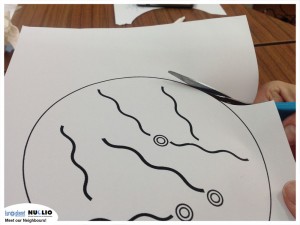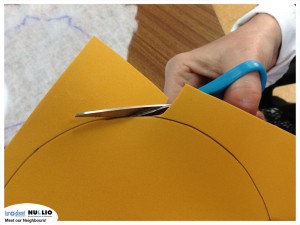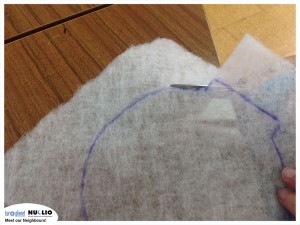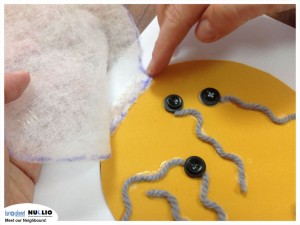:: Description ::
In this activity groups of visually impaired students and their sighted peers are invited to use daily basis items and recycled materials to build a tactile schematic image of a celestial object from our solar system. In a group activity, they are also encouraged to research about our celestial neighbour and its main characteristics.
This activity is planned for groups of children from 6 to 12 years old, and their educators gathered in groups of 3 to 5 children (for example 3 sighted children and two visually impaired). The activity can be implemented at three stages that can be done separately:
- Research on the celestial object by the children prior to the activity;
- Build the tactile image in a hands-on performed by the sighted children closely interacting with their visually impaired peers;
- Tactile exploration of the final schematic image by visually impaired children.
:: Materials ::
Tactile features present in planet Venus and correspondent suggested textures:
- Surface of Venus: thick fabric;
- Volcanoes: Buttons;
- Lava flows: Thread of wool;
- Atmosphere: smooth fabric.
- Black and white prints of image (x2) and mold (x1). Click links to Download.
These materials are only suggestions; all textures can be replaced by local low-cost materials from each community that plans to implement “Meet our Neighbours!”.
:: The Scientist Explains ::
[General Information]
Venus is the second-closest planet to the Sun, with a mean distance of 108 million km. It takes 225 days to revolve around the Sun. With a diameter of 12,100 km, it has a size very similar to that of the Earth.
Like Mercury, Venus never appears very far from the sun in the sky, either as a bright “morning star” or “evening star”. When observed with a telescope, the disk of Venus shows “phases”, just as the Earth’s Moon does to the naked eye, appearing as a crescent, a half-circle, or a fuller circle. As early as 1610, the Italian astronomer Galileo used his observations of the phases of Venus to argue that the planets revolve around the sun, which is at the centre of the solar system.
Like Mercury, Venus transits in front of the sun on rare occasions. The last transits occurred on June 8, 2004, and June 6, 2012, but the next ones will occur in 2117 and 2155. During the 18th and 19th centuries, astronomers used these transits to accurately measure the distance from the Earth to the Sun. Since the scale of the whole solar system was based on that distance, this gave humans the first clear idea of the size of their celestial environment.
[Tactile features]
[While you explore the tactile schematic image you can find:]
Thick layer of clouds
Venus has a thick atmosphere mainly composed of CO2 (96%) and N2 (3,5%), with traces of SO2, argon and water vapour. The surface pressure is 90 times the atmospheric pressure on Earth and the temperature reach 465°C on average. These extreme conditions are caused by an intense greenhouse effect that developed in the early stages of the planet’s climatic evolution and led to the loss of almost all of the initial water content of the atmosphere.
The surface of Venus is permanently veiled by a thick layer of clouds partly composed of sulphuric acid (materialized by the layer of fabric covering the tactile image). These clouds rotate around the planet in about four days, as they are blown by winds with speeds reaching 550 km/h at the equator.
Volcanoes and lava channels
Despite the thick cloud layers, it was possible to “image” the surface of Venus using radar onboard NASA’s probe Magellan that orbited the planet between 1989 and 1994. The image you are using is based on the map established with this technique. Magellan revealed a landscape shaped by ancient volcanic activity, with regions of high plateaus towering 3 to 5 km above vast basaltic plains that occupy about 80% of the surface. These plateaus are traversed by lava channels hundreds of kilometres long (materialized by clumps of soft fabric on the tactile image), originating from many volcanoes (materialized by buttons on the tactile image). More than 1,000 volcanoes or volcanic centres larger than 20 km in diameter dot the surface of Venus. There may be close to a million volcanic centres that are over 1 km in diameter. Many other geological formations are the result of intense volcanic activity in a distant past.
:: Full Activity Description ::
Prior to the activity:
- Gather the children in groups of 5 elements – visually impaired and non-visually impaired (ideally three non-visually impaired to 2 visually impaired);
- Present one image per group;
- Distribute materials accordingly;
During the activity:
- Close supervision – follow each group and explain each of the tactile elements and their correspondence to the each object feature;
- Understand the different needs of each group of students to promote interaction between the children during the building of the tactile image – visually impaired children need to be familiarized with the different materials involved;
Building the tactile image:
This is a step by step guide to the activity of building the tactile image of planet Venus.
STEP 1: Print two copies of 03_Venus_Image.pdf and one copy of 03_Venus_Mold.pdf, in a regular black and white printer;
STEP 2: Cut the outer, round shape of the planet from one of the paper prints;
STEP 3: Place it on top of the thick fabric and with a pen draw the circle;
STEP 4: Cut the round shape again on the thick fabric;
STEP 5: Place abundant glue on the paper image and then place the fabric on top of the glue;
STEP 6: Place glue on the flat surface of the larger button and place it on top of the double circled areas;
STEP 7: Place glue on the flat surface of the smaller button and place it on top of the buttons placed before;
STEP 8: Cut different pieces of different sizes of the thread of wool;
STEP 9: Place abundant glue on the paper image and then place the thread of wool on top of the glue;
STEP 10: Cut the section present on 03_Venus_Mold;
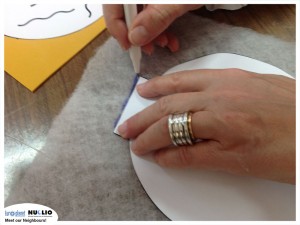 STEP 11: Place the paper mold on top of the soft fabric and with a pen outline the shape;
STEP 11: Place the paper mold on top of the soft fabric and with a pen outline the shape;
STEP 12: Cut the shape of the soft fabric;
STEP 13: Fold the flat section of the soft fabric and place glue on top of it;
STEP 14: Place the glued section on upper limit of the tactile image;
Wait for the image to dry. This may take a while.
:: Exploring the tactile image ::
There are several ways in which you can explore the scientific content of the tactile schematic images.
If you’re presenting the final tactile image to the children, first let them explore and feel the different textures. Questions will arise as the child explores and it is important to guide them. Read “The Scientist Explains” to understand the different features present in planet Venus schematic tactile image.
(1) With the soft fabric covering the overall surface of the planet explain the atmosphere of Venus; After lifting the soft fabric (2) explore the overall thick fabric representing the surface of the planet and the different features present; (3) volcanoes represented by the buttons; (4) and lava flows.
